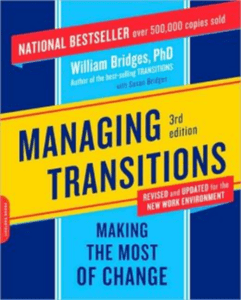A New Year typically begins with new goals, resolutions, or plans which may include groups or teams. In many cases, the new goal or plan may be related to a change and as we know, change can be difficult and disruptive for many.
The Greek philosopher Heraclitus once said “Everything changes, and nothing remains still, and you cannot step twice into the same stream.” For this reason, we need to consider how best to prepare ourselves to lead these teams or groups into 2025, focused on the new goal or plan but mitigating as much disruption as possible.
A simple, easy yet successful process for leading change is utilizing William Bridges Four (4) P’s.
The Four (4) Ps are Purpose, Picture, Plan and Part.
The 1st P – Purpose is what we would call the “burning platform”. Why do we have to change? In many cases the purpose for the change could be economic in nature, whether it is due to competition, related to our reputation in the community or public opinion such as patient satisfaction scores or possibly regulatory expectations. Whatever the reason, we must communicate the “burning platform,” support it with evidence, describe what happens if we do not make the change and communicate the WHO, WHAT, WHEN, WHERE, HOW?
The 2nd P is Picture. Steven Covey, author of The Seven Habits of Highly Effective People said we should “start with the end in mind” You as leader must paint a picture of the future state. What does the road ahead look like is there a comfort zone. During this time is where we want to develop and use change agents in our organization. If possible, create a field trip opportunity so the group can actually see what the change may look like. This is a fantastic opportunity when planning for a new EHR or possibly new or different equipment.
The 3rd P is Plan. Sharing the plan may be easy but making sure we have a good person-oriented plan is the hard part. Outlining all the steps in the plan including timing and a schedule can help prevent those rabbit trails and potential people problems along the way. If possible, use a visual plan such as a Gantt chart with the understanding that the timeline may change but if it does, changes will be communicated and reflected. Provide training, training, training as part of your plan and support along the way.
The 4th P is Part and by far, the MOST important. We have all heard “Teamwork makes the dream work” and that is definitely a true statement. If we want participation and cooperation, we need to ensure we have shared with those involved how important they are to this team, ensure they understand the problem and their role in the solution. If they are involved in the change, they should be consulted if possible before the change is decided. Remember, those at the source of the change can offer a front row seat to how something really works and more than likely offer great solutions. Being a part fosters a sense of belonging and we all like to belong. Right?
Lesson 1 – The Importance of Achieving Goals
- As each goose flaps its wings it creates an UPLIFT for the birds that follow. By flying in a ‘V’ formation the whole flock adds 71 percentage extra to the flying range.
- When we have a sense of community and focus, we create trust and can help each other to achieve our goals.
Lesson 2 – The Importance of Teamwork
- When a goose falls out of formation it suddenly feels the drag and resistance of flying alone. It quickly moves back to take advantage of the lifting power of the birds in front.
- If we had as much sense as geese, we would stay in formation with those headed where we want to go We are willing to accept their help and give our help to others.
Lesson 3 – The Importance of Sharing
- When a goose tired of flying up front it drops back into formation and another goose flies to the point position.
- It pays to take turns doing the hard tasks. We should respect and protect each other’s unique arrangement of skills, capabilities, talents and resources.
Lesson 4 – The Importance of Empathy and Understanding
- When a goose gets sick, two geese drop out of formation and follow it down to the ground to help and protect it.
- If we have as much sense as geese we will stand by each other in difficult times, as well as when we are strong.
Lesson 5 – The Importance of Encouragement
- Geese flying in formation ‘HONK’ to encourage those up front to keep up with their speed.
- We need to make sure our honking is encouraging. In groups and teams where there is encouragement, production is much greater.
- ‘Individual empowerment results from quality honking’ Author Unknown
Think about the Lessons from Geese! A true lesson of fostering belonging and teamwork!

